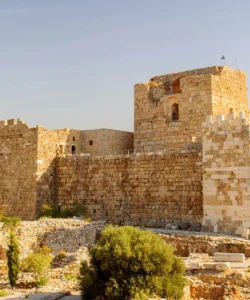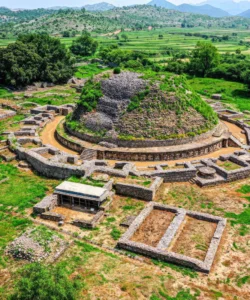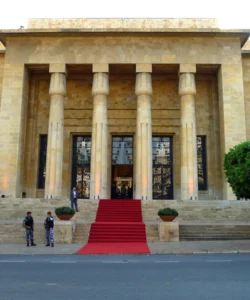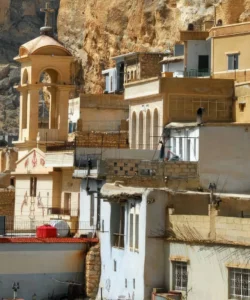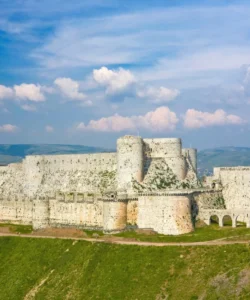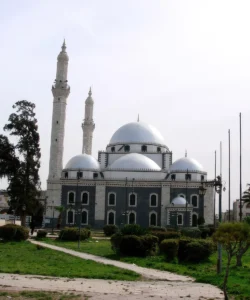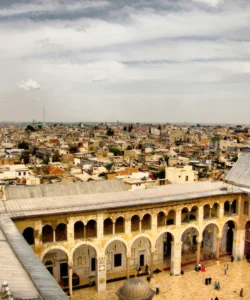The Khalid Ibn Al-Walid Mosque is a prominent mosque in the city of Homs, Syria. It is a significant religious and historical site, recognized for its distinctive Ottoman architecture and for housing the tomb of one of the most celebrated military commanders in Islamic history, Khalid ibn al-Walid.
Listen to an introduction about Khalid Ibn Al-Walid Mosque
Name and Address
Name: Khalid Ibn Al-Walid Mosque (Arabic: مسجد خالد ابن الوليد, Masjid Khālid ibn al-Walīd).
Address: The mosque is located in the Khalidiya district of Homs, Syria, situated in a park along Hama Street in ash-Shuhada Square.
How to Get There
A note on travel: Due to the ongoing civil war and a volatile security situation, many governments advise against all travel to Syria. It is crucial to consult up-to-date travel advisories from your home country before considering any travel to the region.
Assuming safe travel is possible, here is how you would typically get there:
- From Homs city center: The mosque is a major landmark in Homs and is easily accessible by local taxis or a short walk from other central areas.
- From other Syrian cities: Visitors would typically travel to Homs by car or bus and then use local transportation to reach the mosque.
Landscape and Architecture
The mosque’s architecture is a striking example of Ottoman style, blending grandeur with distinct decorative features.
- Distinctive Domes: The mosque is easily recognizable by its series of large, silver-colored domes, with a prominent central dome crowning the prayer hall. This contrasts with the more traditional stone domes found on older Syrian mosques.
- Ablaq Masonry: The exterior walls are decorated with alternating bands of black and white stone, a style known as ablak, which is a hallmark of Mamluk and Ottoman architecture.
- Prayer Hall and Courtyard: The mosque features a spacious prayer hall and a large, open courtyard. The interior is decorated with intricate tilework, elegant arches, and ornate chandeliers.
- Minarets: The building is flanked by two tall, slender minarets that are typical of Ottoman design.
What Makes It Famous
The Khalid Ibn Al-Walid Mosque is famous for its historical and religious importance.
- Tomb of Khalid ibn al-Walid: The mosque’s primary claim to fame is that it houses the tomb of Khalid ibn al-Walid, a companion of the Prophet Muhammad and a legendary military commander who was known as the “Sword of Allah.” His tomb has made the mosque a significant pilgrimage site.
- Ottoman Architecture: The mosque is one of the most prominent examples of Ottoman architecture in Syria, built in the early 20th century.
- Symbol of Homs: The mosque is considered a symbol of the city of Homs and has a history of serving as a platform for political activism.
Differences from Some Other Wonders (e.g., The Umayyad Mosque)
While both are major mosques in Syria, the Khalid Ibn Al-Walid Mosque and the Umayyad Mosque in Damascus have significant differences.
- Historical Era: The Umayyad Mosque is an ancient monument from the 8th century CE, representing the dawn of monumental Islamic architecture. The Khalid Ibn Al-Walid Mosque, in its current form, is a much newer building, dating from the early 20th-century Ottoman period.
- Architectural Style: The Umayyad Mosque is defined by its classical Greco-Roman foundation and its unique early Islamic design, including a large open courtyard and a three-aisled prayer hall. The Khalid Ibn Al-Walid Mosque is a quintessential example of Ottoman style, with its distinctive silver domes and ablak masonry.
- Foundation: The Umayyad Mosque was built on a site that had been a continuous place of worship for millennia, including a Roman temple and a Byzantine basilica. The Khalid Mosque was built on the site of an earlier Mamluk-era mosque, which was built around the tomb of Khalid ibn al-Walid.
Khalid Ibn Al-Walid Mosque Photos:
































